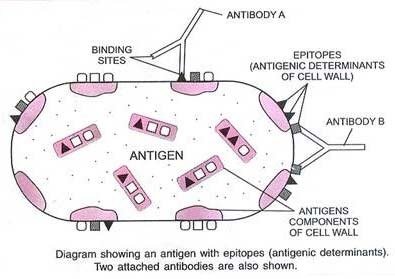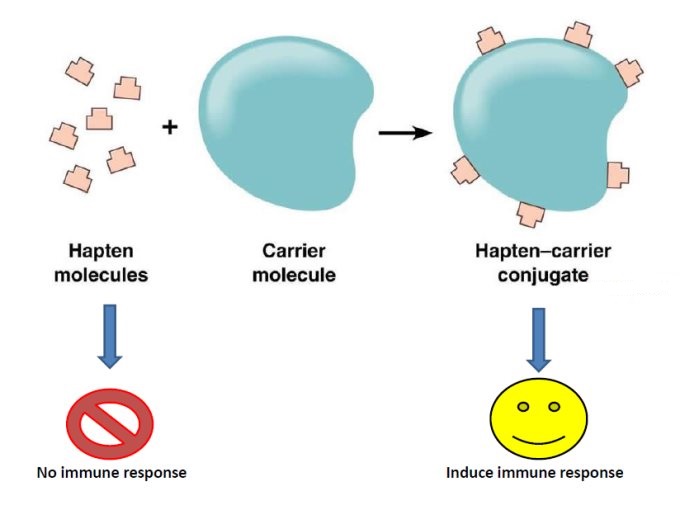
- A protein or carbohydrate that evokes our immune system and initiates the immune response is called an immunogen.
- Immunogens are associated with an infectious agent like bacterium, virus, fungus or parasites.
- Antigen is a protein or polysaccharide, which when introduced into a living animal evokes a humoral (production of specific antibody) and/or cell-mediated immune response (production of specially sensitized T-cells).
- Immunogens contain one or more than one antigens, e.g. flagellar and somatic antigens of bacteria.
- Antigens have the ability, called antigenicity that helps them bind or combine with specific antibodies or receptors on the T-cell surface.
- These surfaces of antigens binding with antigenic specific membrane receptors on lymphocytes, antibodies or T-cells receptors are called epitopes or antigenic determinants.
Types of antigens:
- Complete antigen or immunogen:
- Molecules (proteins or polysaccharides) that are capable of inducing an immune response by themselves are called complete antigen.
- They have high molecular weight (more than 10,000).
- Bacteria, fungi, parasites, viruses are complete antigens.
- Incomplete antigen or hapten:
- They are usually non-proteinous substances
- They are unable to induce immune response by themselves and hence require a carrier molecule to make them immunogenic.
- Serum Protein such as Albumin or Globulin which are non-antigenic components but act as carrier molecules to induce the immune response.
- They have low molecular weight (less than 10,000).
- Complex haptens (e.g. capsular polysaccharide of Pneumococci, cardiolipin) are relatively larger molecules and form visible precipitate combining with specific antibodies.
- Simple haptens are smaller molecules and don’t form visible precipitate with antibodies.
- Polysaccharide “C” of beta-haemolytic Streptococci, glycoproteins etc. are some examples of haptens.

- Alloantigens:
- These are body’s own cells or compounds or the antigenic products that are processed by the macrophages which are later accepted by the cytotoxic T – cells.
- These antigens are present in one individual but not in other of the same species.
- Examples: Blood group antigens (A and B on RBC surface), HLA (Histocompatibility Leukocyte antigens), etc.
- Autoantigens:
- An autoantigen is usually a normal protein or complex of proteins (and sometimes DNA or RNA).
- Autoantigens are Proteins like lens protein, sperm protein, myelin basic protein, DNA, thyroglobulin etc. that are sequestered from own blood circulation and when injected in blood, induce an immune response.
- They are recognized as antigens by the immune system of patients suffering from a specific autoimmune disease.
- These antigens under normal conditions are not the target of the immune system.
- Sometimes due to genetic and environmental factors, the normal immunological tolerance for such an antigen is lost in these patients.
- Heterophilic or cross-reacting antigens:
- If antibody produced against one antigen binds against other antigen, such antigens are called heterophilic or cross-reacting antigens.
- These antigens are of similar nature but are not identical and are present in different tissues of more than one species.
- Examples: antibody produced against Rickettsia binds some Proteus species; antibody produced against M-protein of S. pyogens binds with heart muscles of human beings.